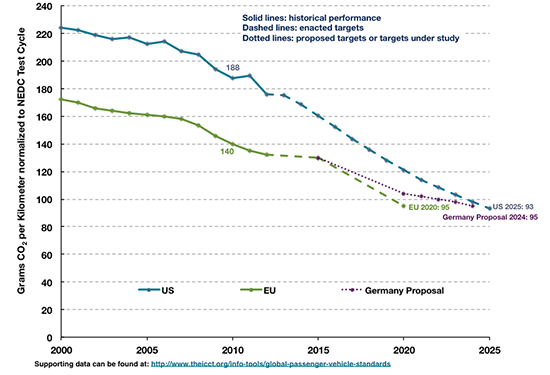Blog
The EU CO2 standards thriller, continued
We noted previously how EU light-vehicle CO2 standards were delayed earlier this year due to intervention from the German government. Now that the German elections are behind us, Germany has come forward with a new proposal that would amount to postponement of the 95g/km CO2 emission target. Under the proposal, the regulation becomes less stringent: only 80% of new cars must meet 95g/km CO2 emission targets in 2020, 85% in 2021, 90% in 2022, 95% in 2023. The 95g/km target is only fully phased in 2024.
European NGOs translated the percentage fleet achievement to effective targets for the phase-in years, using 2012 new car fleet data. Making use of this data, in the chart below, we contrast the German proposal to the original European Commission proposal as well as the GHG standards adopted by the US.
If this new German proposal were to be adopted, the EU would lose its advantage over U.S. passenger cars in terms of vehicle efficiency. This would be quite extraordinary. In 2010, U.S. passenger car emissions were a third higher than EU car emissions. Under the German proposal, that gap would all but vanish by 2024.
The stringency of the U.S. and EU standards as well as the German proposal can be compared in another manner. From 2012 to 2025, the U.S. standards aim to reduce car GHG emissions annually by 4.8%. The European Commission proposal targeted a 4% annual reduction. In contrast, the German proposal would amount to a mere 2.7% annual reduction in new vehicle CO2 emissions.
The Chairman of the European Parliament Committee on the Environment, Matthias Groote, rejected Germany’s proposal, saying “A deal is a deal.” Similarly, Connie Hedegaard, the EU’s Commissioner for Climate Action, tweeted “Time to approve the deal!” A Member State vote is scheduled for 2 October, and the EU light-duty CO2 file remains thrilling until the last minute.

